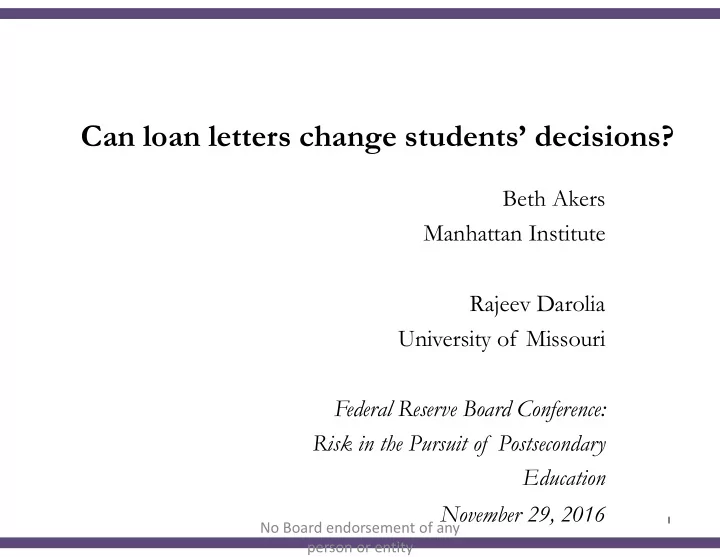

Can loan letters change students’ decisions? Beth Akers Manhattan Institute Rajeev Darolia University of Missouri Federal Reserve Board Conference: Risk in the Pursuit of Postsecondary Education November 29, 2016 1 No Board endorsement of any person or entity
Overview Institutions and policymakers have the incentive for students to make informed borrowing decisions Loan letters are a low-cost way to provide information Evidence presented today: Experimental evaluations of informational letters at 2 universities General finding: No (or limited) effects on borrowing overall; Some evidence that some student subgroups changed behavior 2 No Board endorsement of any person or entity
% of balance 90+ days delinquent 15% 10% 5% 0% 2004 Q1 2005 Q1 2006 Q1 2007 Q1 2008 Q1 2009 Q1 2010 Q1 2011 Q1 2012 Q1 2013 Q1 2014 Q1 2015 Q1 Credit Card Student Loan Auto Loan Mortgage Source: Federal Reserve Bank of New York Quarterly Report on Household Debt and Credit (February 2016). Lines are the 3 3 percentage that are at least 90 days delinquent for different segments of consumer credit. No Board endorsement of any person or entity
Are students making ill-informed student loan decisions? Students knowledge of borrowing 1/8 to 1/3 of borrowers report no loan debt; 40%-50% underestimate amount owed (Andruska et al. 2014; Akers & Chingos 2015) Online counseling viewed as ineffective (Fernandez 2015) Evidence that information (and often other things) can change educational and financial decisions (e.g., Barr, Bird, & Castleman, 2016; Bettinger et al. 2012; Castleman & Page, 2015; Hoxby & Turner 2013; Marx & Turner, 2016) 4 No Board endorsement of any person or entity
Policy context & related evidence Students do not receive financial statements on federal loans Indiana U System: Large borrowing ↓ Debt letter + Office of Financial Literacy; Completion programs; 1:1 counseling Indiana House Enrolled Act 1042 Montana State U: Marginal borrowing ↓ , Academic perf ↑ (Schmeiser, Stoddard, & Urban 2016) Normative debt letter + $ incentive to participate in 1:1 counseling 5 No Board endorsement of any person or entity
6 No Board endorsement of any person or entity
Information-related issues Lack of access to information Particularly among communities where not many go to college Information is not salient, or only partially salient Students may know annual borrowing, but not cumulative debt Future payments Computational errors processing information Comparing current benefits to future costs (Frederick et al. 2002) Risk aversion (Cadena & Keys 2013; Chatterjee & Ionescu 2010) 7 No Board endorsement of any person or entity
Our study Field experiments on the efficacy of informational loan letters 4 universities ~20,000 students Variation in letters (formats, delivery, content, duration) Follow-up surveys and interviews Today: preliminary findings from 2 universities Difference from other interventions Randomized treatment and control groups Few additional large scale systematic supports Do not encourage less borrowing goal is informed decision making 8 No Board endorsement of any person or entity
Loan letters Letter presents clear information about borrowing Estimated future monthly payments (standard 10 year repay plan) Peer borrowing: median total loan debt of graduates When knowledge is limited rely on peers Clear summary about cumulative borrowing Encourage progress toward degree in some settings Other potential benefits Reminder about debt Highlights avenues for help Signal of interest and care from the university 9 No Board endorsement of any person or entity
Settings University 1: University of Missouri-Columbia (“MU”) Predominantly residential, large flagship public land-grant university Sample (N=9802) includes all UG students who borrowed in a prior academic year Delivery: email and online University 2: Anonymous U (“AU”) Large public research university Sample (N=5660) includes 1 st & 2 nd year students with valid FAFSA Delivery: mail and email Randomly assigned to treatment (received letter) and control (did not receive letter) groups 1 0 No Board endorsement of any person or entity
Example loan letter: MU 11 No Board endorsement of any person or entity
Estimation Base model estimates: E is the treatment effect: E Y Letter = 1, X - E Y Letter = 0, X Demographic, academic, and financial controls in X -vector (all measured pre-notice) 12 No Board endorsement of any person or entity
Effect of letter on borrowing No observable effect on amount or rate of borrowing in either setting Student subgroups (MU) Low GPA students less likely to borrow and borrow less Financial literacy? Student self-awareness? Limited or no evidence of effect on the borrowing of first generation students, minority students, and those with low EFC 13 No Board endorsement of any person or entity
Effect of letter on other outcomes No improvement in ability to identify amount borrowed (AU) No improvement in rate of being “on track” to graduate (AU) Increased contact with FAO (MU) Driven by ↑ visits by those with moderate PY borrowing 14 No Board endorsement of any person or entity
Still much to do Incorporate findings from other institutions Additional outcomes (Spending; Credits earned/Dropouts; Aid application) Dig into mechanisms with interviews/surveys 15 No Board endorsement of any person or entity
Discussion Overall, loan letters do not lead to large scale systematic changes in student borrowing behavior Some evidence of lower borrowing among those with low GPAs More contact with FAO may lead to better repayment or other downstream decisions Suggests outcomes in other settings driven by other simultaneous changes in institutional policy Implementation/institutional constraints/scalability Timing of intervention? 16 No Board endorsement of any person or entity
An attempt at a poem Do students know the cost of their loans? We think they may not know what they’ve sown; So we sent them a letter; In hopes decisions would be better; But alas, information is not sufficient alone. 17 No Board endorsement of any person or entity
Rajeev Darolia University of Missouri 573-884-5247 DaroliaR@missouri.edu 18 No Board endorsement of any person or entity
Recommend
More recommend